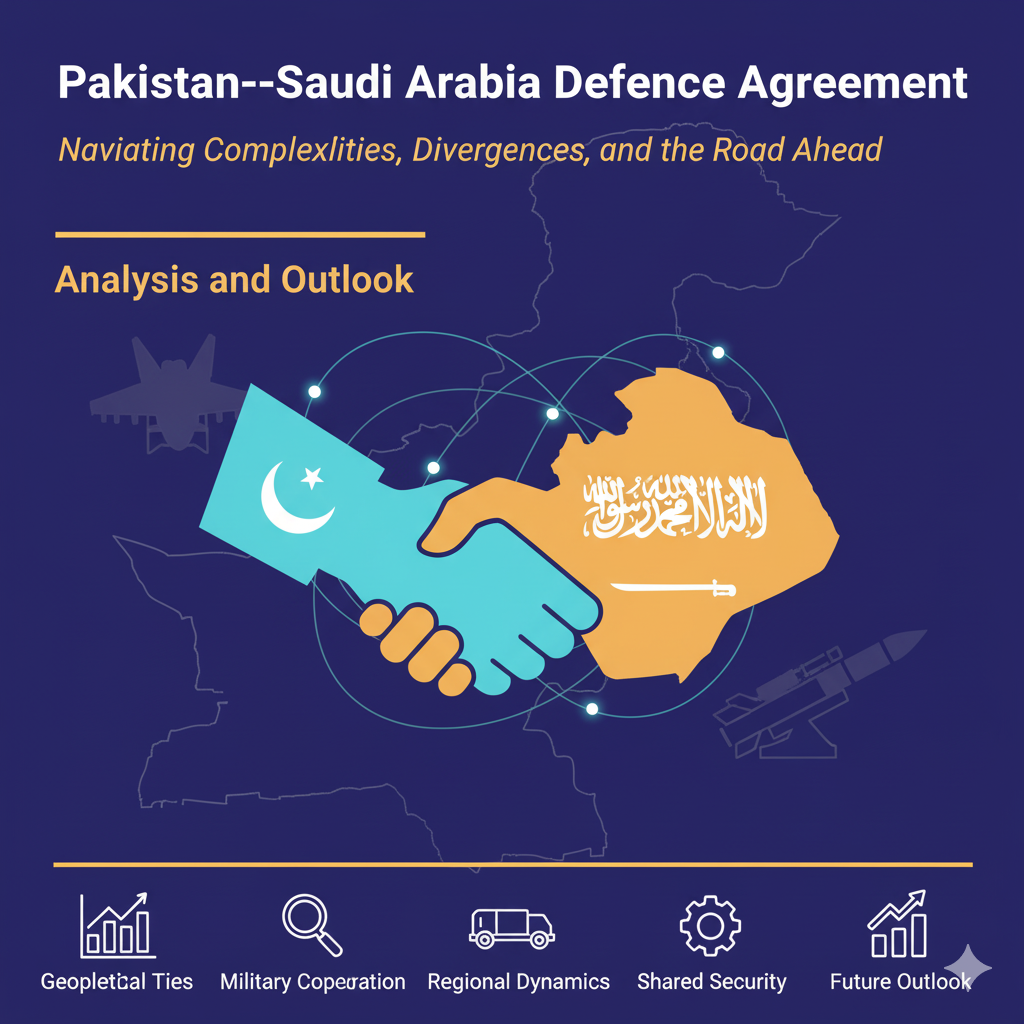In September 2025, Pakistan and Saudi Arabia signed a landmark Strategic Mutual Defence Agreement, marking a new phase in their historically close yet fluctuating relationship. The pact has been hailed as one of the most ambitious bilateral defence arrangements between South Asia and the Middle East, carrying commitments that extend to collective deterrence, intelligence cooperation, defence production, and clauses that resemble NATO’s Article 5. While the announcement generated optimism in both Islamabad and Riyadh, it also raised pressing concerns over how credible such an alliance could be in practice, what risks it might bring, and how it could reshape the balance of power in South Asia and the Gulf.
The defence agreement emphasizes several key areas. It pledges collective defence in which an attack on either state is considered an attack on both. It also includes joint military training programs, naval drills, and counter-terrorism operations to strengthen security capabilities. Another major component is defence industrial cooperation, particularly in weapons manufacturing, UAV technology, and cyber defence. Intelligence sharing is also a core aspect, with both sides promising enhanced real-time collaboration to counter terrorism and regional threats. However, many details—such as operational triggers, deployment logistics, and any nuclear-related guarantees—remain deliberately vague, leaving plenty of room for interpretation and speculation.
The timing of this pact is significant. Saudi Arabia continues to face security risks after years of conflict spillovers from Yemen, while Pakistan struggles with persistent terrorism and instability along its borders. Both countries are also seeking to recalibrate their foreign relations. For Riyadh, diversifying security partners beyond the United States is a strategic priority, whereas Islamabad hopes to revive strong Gulf ties and attract Saudi investment as part of its broader economic revival. Economic diplomacy is therefore as central to this agreement as military cooperation.
A particularly sensitive dimension of the pact is the speculation surrounding Pakistan’s nuclear status. As a nuclear-armed nation, some analysts immediately wondered if the deal implied a form of extended deterrence for Saudi Arabia. While there is no official confirmation that Riyadh would fall under Pakistan’s nuclear umbrella, even the perception of such a guarantee alters regional security calculations. Yet, experts caution that any formalization of this would breach global non-proliferation norms, carry severe diplomatic consequences, and potentially destabilize the region further. Most agree that nuclear assurances, if they exist at all, are symbolic rather than operational.
The regional and global reactions to the defence agreement have been telling. India is closely monitoring developments, wary of a stronger Saudi-Pakistan bloc that could indirectly affect South Asian security dynamics. Iran is likely to view the pact as part of a broader Gulf containment strategy, further fueling distrust toward Riyadh. The United States has remained publicly neutral, though privately cautious about nuclear undertones, while China has welcomed the agreement, seeing it as aligned with its Belt and Road vision that seeks to link South Asia and the Gulf in long-term infrastructure and security partnerships.
For Pakistan, the potential benefits are substantial. It could see an inflow of Saudi investment in energy and infrastructure, a boost to its diplomatic stature, and access to advanced military hardware. For Saudi Arabia, the partnership offers the credibility of aligning with a battle-hardened army, access to Pakistan’s defence industry, and a stronger hedge in an uncertain regional security environment. Yet, these opportunities come with significant risks. Without clearly defined protocols, both sides face the danger of misinterpretation during a crisis. Pakistan may find itself entangled in Middle Eastern conflicts that it would prefer to avoid, while Saudi Arabia could complicate its expanding relations with India. Domestic political critics in Pakistan also argue that the country should prioritize its own internal security challenges before committing to external entanglements.
Looking ahead, the credibility of the agreement will depend on whether both states move beyond symbolism and establish practical joint defence mechanisms. This means clearly defining red lines, operational triggers, and rules of engagement. Transparency will also be essential to avoid misinterpretation and unnecessary escalation. At the same time, both countries must balance deterrence with diplomacy by keeping communication channels open with other regional powers. Importantly, the defence relationship should be paired with deeper economic cooperation in trade, investment, and energy, ensuring that security commitments also generate tangible development gains.
With global interest in the Pakistan–Saudi defence pact 2025 at its peak, analysts and readers are searching for insights under terms like “Pakistan Saudi defence agreement analysis,” “Pakistan Saudi military cooperation,” and “strategic defence pact South Asia Gulf.” Including these concepts naturally improves discoverability, ensuring that this critical development is properly understood by policymakers, scholars, and the wider public.
In conclusion, the Pakistan–Saudi Arabia Defence Agreement of 2025 is not just a military pact but a strategic signal with long-lasting consequences. It strengthens bilateral ties and enhances deterrence, but it also introduces new complexities that demand careful management. If implemented with clarity and restraint, it has the potential to redefine South Asia–Gulf security relations for the next decade. If left vague and undefined, however, it risks becoming another grand diplomatic gesture without real substance. The road ahead will determine whether this agreement becomes a cornerstone of regional security or a missed opportunity in the fast-shifting geopolitics of the Muslim world.







